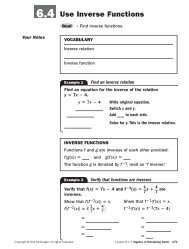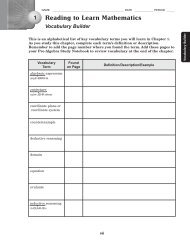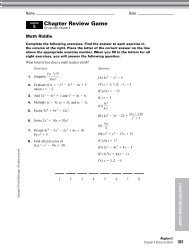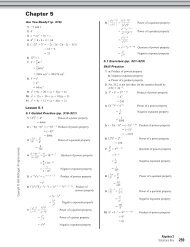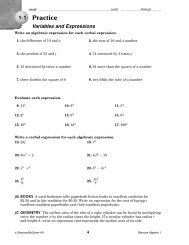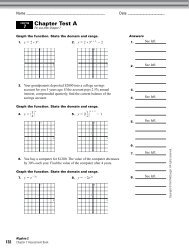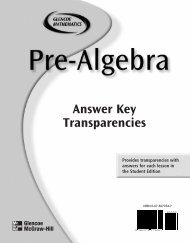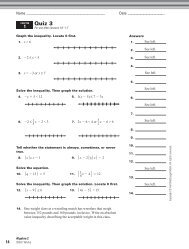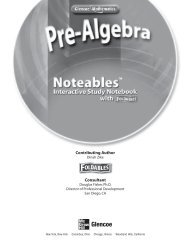Study Guide and Intervention (continued) - MathnMind
Study Guide and Intervention (continued) - MathnMind
Study Guide and Intervention (continued) - MathnMind
You also want an ePaper? Increase the reach of your titles
YUMPU automatically turns print PDFs into web optimized ePapers that Google loves.
6-3<br />
Solve Inequalities Involving the Distributive Property When solving<br />
inequalities that contain grouping symbols, first use the Distributive Property to remove the<br />
grouping symbols. Then undo the operations in reverse of the order of operations, just as you<br />
would solve an equation with more than one operation.<br />
Example<br />
Solve 3a 2(6a 4) 4 (4a 6).<br />
3a 2(6a 4) 4 (4a 6) Original inequality<br />
3a 12a 8 4 4a 6 Distributive Property<br />
9a 8 2 4a Combine like terms.<br />
9a 8 4a 2 4a 4a Add 4a to each side.<br />
5a 8 2 Combine like terms.<br />
5a 8 8 2 8 Subtract 8 from each side.<br />
5a 10 Simplify.<br />
a 2 Divide each side by 5 <strong>and</strong> change to .<br />
The solution in set-builder notation is {a⏐a 2}.<br />
Exercises<br />
NAME ______________________________________________ DATE ____________ PERIOD _____<br />
<strong>Study</strong> <strong>Guide</strong> <strong>and</strong> <strong>Intervention</strong> (<strong>continued</strong>)<br />
Solving Multi-Step Inequalities<br />
Solve each inequality. Then check your solution.<br />
1. 2(t 3) 16 2. 3(d 2) 2d 16 3. 4h 8 2(h 1)<br />
4. 6y 10 8 (y 14) 5. 4.6(x 3.4) 5.1x 6. 5x (2x 3) 1<br />
7. 3(2y 4) 2(y 1) 10 8. 8 2(b 1) 12 3b 9. 2(k 1) 8(1 k)<br />
10. 0.3( y 2) 0.4(1 y) 11. m 17 (4m 13)<br />
12. 3n 8 2(n 4) 2(1 n) 13. 2(y 2) 4 2y<br />
14. k 17 (17 k) 15. n 4 3(2 n)<br />
Define a variable, write an inequality, <strong>and</strong> solve each problem. Then check your<br />
solution.<br />
16. Twice the sum of a number <strong>and</strong> 4 is less than 12.<br />
17. Three times the sum of a number <strong>and</strong> six is greater than four times the number<br />
decreased by two.<br />
18. Twice the difference of a number <strong>and</strong> four is less than the sum of the number <strong>and</strong> five.<br />
© Glencoe/McGraw-Hill 356 Glencoe Algebra 1



